Feeding is the most important factor in successful livestock farming. Animal feed is the food given to domestic animals, especially cattle, during animal husbandry. Animal feed is food given to animals, often referred to as fodder, during the care and management of farm animals by humans for profit. This category mainly includes cattle, goats, sheep, pigs, donkeys, and horses. Other animals, including buffalo, oxen, llamas, and camels, may dominate the agriculture of other regions.
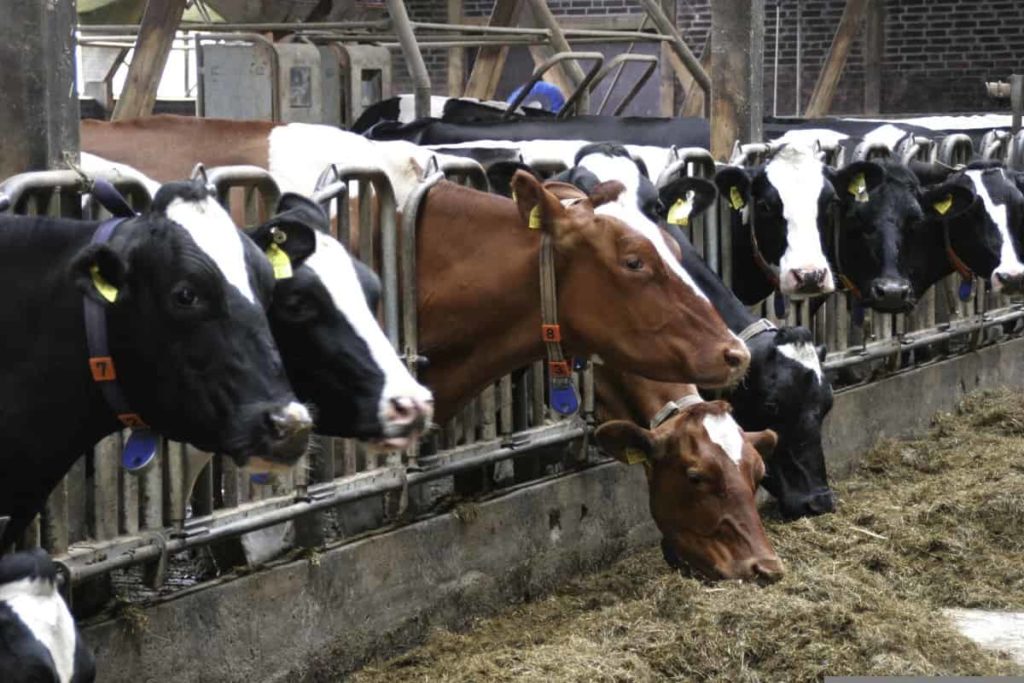
Overfeeding will be wasteful and uneconomical and may cause health problems in livestock. A successful farmer will feed at an ‘optimal level.’ In other words, he will feed as much as is needed for maximum production. It takes a lot of skill, knowledge, and practice to feed animals in the best possible way. The main step is to understand the different types of food the animals can eat. Also, learn how different foods can be combined to create a balanced ratio for animals.
A guide to understand livestock feeding
Why is feed management important in livestock?
- Feed is the single largest nutrient source brought into livestock farming. In addition, forage composition and utilization in livestock diets have a significant impact on nutrient uptake and, potentially, nutrient balance in the field.
- Feeding livestock animals is both an art and a science. It is science inspired by years of research and art developed by centuries of practical experience.
- Like humans, livestock needs a balanced diet that contains all the necessary nutrients, fluids, minerals, and vitamins.
What is the best feed for livestock?
- Maize, Oats, and Barley are the main grains fed to livestock. Oats, which have a low energy value due to their high fiber content, are considered a “safe” grain in terms of potential digestive disorders.
- Feeding a balanced diet, avoiding overfeeding, and an ample supply of cool, clean, and fresh water will help improve feed and nutrient utilization on the farm. It is impossible to have all the nutrients in perfect balance in commercial or functional diets, but as farmers, we do our best to meet the nutritional needs of animals.
- Overfeeding can be harmful to animals and the environment. Water is the cheapest, most abundant, and least understood of all the nutrients required for livestock production.
- Animal feed is classified as concentrated, high in energy value, including fat, cereal grains and their by-products (Barley, Corn, Oats, Rye, Wheat), high in protein; Oily meal or cake (Soybean, Canola, Cottonseed, Peanut), and Sugar Beet, Sugarcane are important for animal feed.
What is the most common cattle feed?
- Grains serve as the basis of most commercially produced and domestic livestock feed. Corn is the most commonly used grain for livestock feed due to its low cost and relatively high nutritional value. Soy and Barley are also used to supplement corn and provide a greater variety of nutrients.
- There are different systems of cattle feeding in animal husbandry. For grazing animals, the grass is usually the forage that makes up most of their diet. Cattle raised in feedlots are fed supplemental hay with grain, soy, and other ingredients to increase the energy density of the feed. Cattle should be raised on forage that consists primarily of grass or concentrates.
- Cattle feed contains protein, energy, minerals, and vitamins for animal growth, maintenance, and milk production. It is beneficial to feed pregnant animals with additional fodder for proper development. It increases reproductive performance, milk production as well as milk fat content. Growing animals should be fed 1 to 1.5 kg of compound cattle feed daily. About 2 kg of compound cattle feed for body maintenance and 400 grams of cow and 500 grams of buffaloes for every liter of milk should be fed to milking animals.
- In addition to this amount, 1 kg of compound cattle feed and 1 kg of good quality oil cake should also be given to pregnant animals during the last two months of pregnancy.
In case you missed it: Top Cattle Feed Manufacturers in India: Companies List
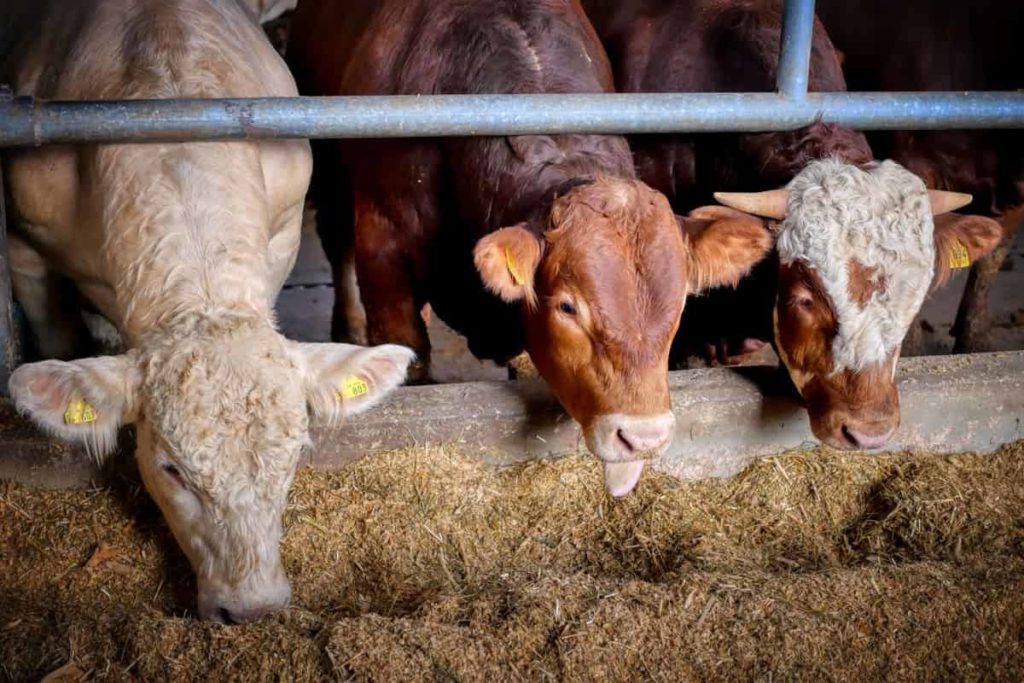
How much feed should a sheep eat per day?
- A grower’s ration can be fed at 2.5 to 3.0 pounds per day. Good quality, long-stemmed hay should always be available to provide adequate fiber to prevent indigestion. Sheep make the best use of high-quality roughage, either hay or low moisture, grass-legume silage, or occasional chopped green feed. Good quality hay or stored forage is a highly productive feed. No matter how much is available, poor-quality fodder is only suitable for maintenance.
- Sheep choose to graze on pasture while goats feed on leaves, browse, and vines of trees in bushes and forests. Their rumination time is approximately the same as grazing time, depending on the feed content.
- For finishing lambs, use one to two pounds of potatoes daily along with alfalfa hay and grain; for ewes up to lambing, use 2-2.5 pounds per day, with alfalfa hay increasing to 4 pounds per day after lambing. Cooking potatoes for feed does not add value and may reduce palatability. Because potatoes are so tasty, lambs may overeat, potentially leading to acidosis. It can result in lambs being deprived of food or possibly dying. Therefore, potatoes should be gradually introduced into the diet.
How many times a day should I feed my cattle?
Traditionally, dairy producers feed their cattle a total mixed ration (TMR) twice daily. However, many producers feed their cows only once daily to reduce labor costs. Feeding dairy cattle is the most expensive part of their care. In progressive dairies, each cow’s feed intake is measured/calculated, and milk production per cow is monitored to determine if the cow is producing the desired (optimal) amount of milk. If the production is less than expected, the feed is increased to achieve higher milk production.
Some cows gain weight but do not produce much milk; these cows are usually “culled” from the herd and replaced by higher-yielding cows. Dairy rations require high protein levels, as reflected in soybean and alfalfa intake. Limestone and phosphate must be balanced to ensure the proper ratio of calcium and phosphorus for milk production. Rations are usually calculated using computer programs.
Why do we feed livestock?
Without adequate food, i.e., ration, animals cannot grow well, maintain good health, or produce well products and young. Therefore, we have to give the animals nutritionally balanced and adequate rations. Therefore, it is important to feed the cattle scientifically according to their physiological needs.
Forages used for livestock feeding can be divided into three major classes:
- Green or succulent fodder or forage;
- Dry forages or fodder; and
- Concentrated feeds
Forage means green and dry are also called bulk feeds or roughages, as they are bulkier due to their higher fiber content. They contain fewer nutrients per unit weight. Cultivated feed and fodder means all essential by-products of the cultivation of farmers’ crops, regardless of their nutritional quality.
Natural vegetation is that which occurs in nature without human effort. On the other hand, certain nutrients are added to feed or rations to provide certain nutrients or groups of nutrients. It is done to provide important high-value nutrients in small amounts. Due to the scarcity of livestock feed in the country, many non-traditional feeds ranging from tree leaves to seaweed, are being prescribed as animal feed, especially during periods of scarcity.
In case you missed it: Jersey Cow Farming, Feed Chart, Milk, Breed Facts
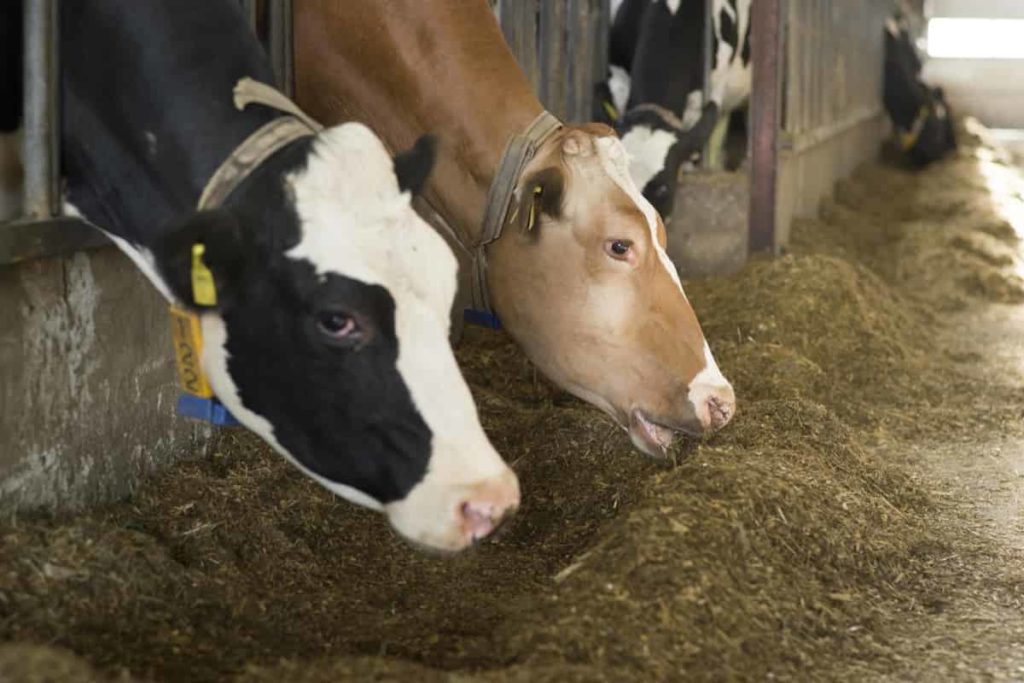
How can feed efficiency be increased?
One way to improve feed efficiency is to increase milk yield with the same dry matter intake, and the other is to decrease dry matter intake and maintain the same milk yield. Many dietary changes that increase milk production will also increase feed efficiency. The easiest method to improve livestock feed efficiency is to avoid overfeeding animals. In cattle, excess nutrient intake increases rumen CH4 emissions and wastes money on supplemental feed.
Formulating diets based on the animal’s physiological needs will prevent overfeeding and ensure that the animal is accessing adequate amounts of vitamins, minerals, protein, and fiber. Animal nutritionists can analyze feed nutrients and formulate diets with ideal combinations of protein, minerals, and other essential nutrients. They are reducing GHG emissions due to poor feed efficiency.
The feed can also be ground or pelleted to reduce the amount of animal digestion. When feed size is reduced, total CH4 emissions are reduced by 20 to 40 percent. Maintaining adequate animal health will also ensure that the animal has the prerequisites for digesting and absorbing nutrients and reducing the potential for loss of dietary energy. Adding fats or vegetable oil can improve feed efficiency by reducing feed intake.
What is the importance of feed for animal growth?
- Like humans, livestock needs a balanced diet that contains all the necessary nutrients, fluids, minerals, and vitamins. Proper nutrition stimulates your animals to grow, develop and reproduce and provides a strong immune system to fight infection.
- Feeding directly affects the growth rate, productivity, and health status of animals. Feeding is key to a profitable and sustainable farm. Feed costs have long been recognized as the largest cash outlay in animal production.
- Whether you feed your commercial livestock feeds such as concentrates or farm-raised foods, you need to ensure that each ration meets the essential nutritional needs of each animal during its various life stages.
- The nutritional requirements of animals can vary between different species, within the same species, under different conditions, or under external factors. Feed supplements can greatly increase the productivity of your farm animals. The importance of proper nutrition in livestock production cannot be overstated. Feed determines the overall health and production performance of livestock. Livestock feed production and consumption are driven by population and income growth, which increases the demand for milk and, thus, the demand for feed.
What are the feeding tips for livestock animals?
Feeding a balanced diet, avoiding overfeeding, and an ample supply of cool, clean, and fresh water will help improve feed and nutrient utilization on the farm. It is impossible to have all the nutrients in perfect balance in a commercial or practical diet, but we want to come close to meeting the animal’s nutritional needs. If the diet is balanced, the animal’s total production will be limited to that “limiting nutrient” level, and all other nutrients will be wasted.
Overfeeding can be harmful to animals and the environment. Excess feed is often wasted and can remain in the feeding area, become contaminated, and end up in the compost pile. Water is the most abundant and cheapest nutrient required for livestock production.
What are the main types of feed in livestock?
- Animal feed is an important input and is often the primary cost of raising or raising animals.
- Livestock feed is divided into different food groups that play an important role in animal health and well-being.
- Vitamins are micronutrients that help improve animal resistance to disease and act as cofactors for enzymes.
- Protein is an essential ingredient in many livestock diets. Protein is a macronutrient that contains nitrogen and equips rumen microorganisms to help digest food. Carbohydrates provide the primary source of energy for livestock.
- Water is the most important component of livestock feed and ensures normal biochemical and physiological conditions.
- Minerals help in the proper growth and reproduction of animals. Fats have a higher caloric output per unit than carbohydrates and are also a rich energy source.
In case you missed it: Common Mistakes in Goat Farming: For First Time Goat Owners
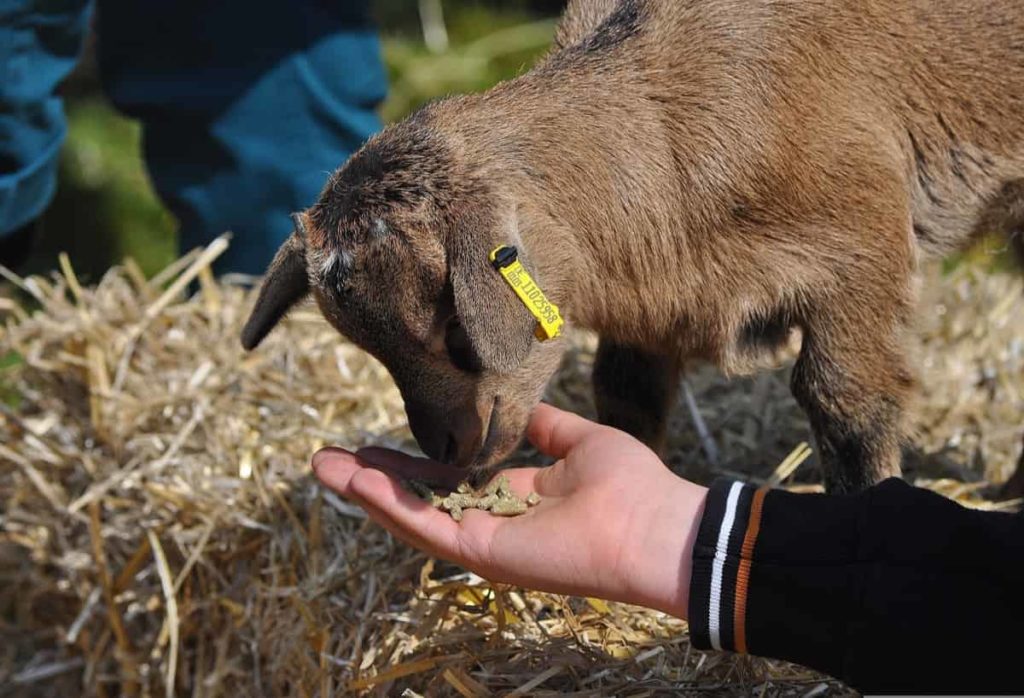
What are the factors affecting feed quality?
Every effort should be made to use high-quality feed. For ruminants to reach optimum production levels, the fodder must be of excellent quality. Those with high fiber content or rain during production will produce lower production levels and be more expensive to the producer. And this can result in higher levels of nutrients. Every additional day past the optimum harvest date for hay in the summer will result in reduced forage quality and higher costs to the producer. It is an important point to remember.
A more timely forage harvest will improve quality, producing higher profits for the producer and less loss of feed and nutrients. The feed’s nutritional value is determined by analyzing the number of different nutrients it contains, which will be available to the animal for maintenance, growth, and production. It should be determined in terms of energy, protein, minerals, and vitamins.
The simplest and earliest method of determining the nutritional value of a feed was to estimate the composition of the feed to the various nutrients. It was soon discovered that large amounts of nutrients are lost through faeces and that the nutritional value of feedstuffs is more accurately estimated when digested nutrients are taken into account. As a result, feeding trial and digestibility trial techniques were developed.
Numerous digestibility trials have been conducted worldwide to determine the digestible nutrients in different cattle diets for different livestock types under different conditions and activities. The demand for livestock feed in the country is high due to the increase in demand for milk and meat due to a large number of livestock and population growth.
How do you feed dairy cows for maximum production?
To increase milk production, dairy cows should be fed on dry matter such as hay or silage rather than green or fresh grass. It is because the microbes found in the rumen of all ruminants don’t work on any feed, especially a high fiber diet when not fermented. Concentrate should be fed individually according to production requirements. A good quality rug saves concentration.
About 20 kg of grass (Guinea, Napier, etc.) or 6-8 kg of legume fodder (Cowpea, Lucerne) can replace 1 kg of concentrate mixture (0.14-0.16 kg of DCP) depending on the protein content. About 1 kg of straw can replace 4-5 kg of hay on a dry matter basis. In this case, protein deficiency and other nutrients should be supplemented with a suitable compound. High-yielding animals can be fed three times daily (roughage and concentrate). Increasing the frequency of concentrate feeding will help maintain normal rumen motility and optimal milk fat levels.
Overfeeding may result in food loss and indigestion. Sudden changes in feed should be avoided. Grain should be ground to a medium fine before feeding to livestock. Forages with long and thick stems, such as Napier, can be chopped and fed. Very moist and soft hay can be wilted or mixed with straw before feeding.
Legume fodder can be mixed with straw or grasses to prevent bloat and indigestion. Silage and other feeds can add flavor to milk and be fed after milking. The mixture in the form of a mash can be moistened with water and fed immediately. Pellets can be fed like this. All feeds should be appropriately stored in ventilated and dry places. The mouldy or otherwise spoiled feed should not be fed.
In case you missed it: Goat Farming Insurance in India, Companies, Policies, and Premiums
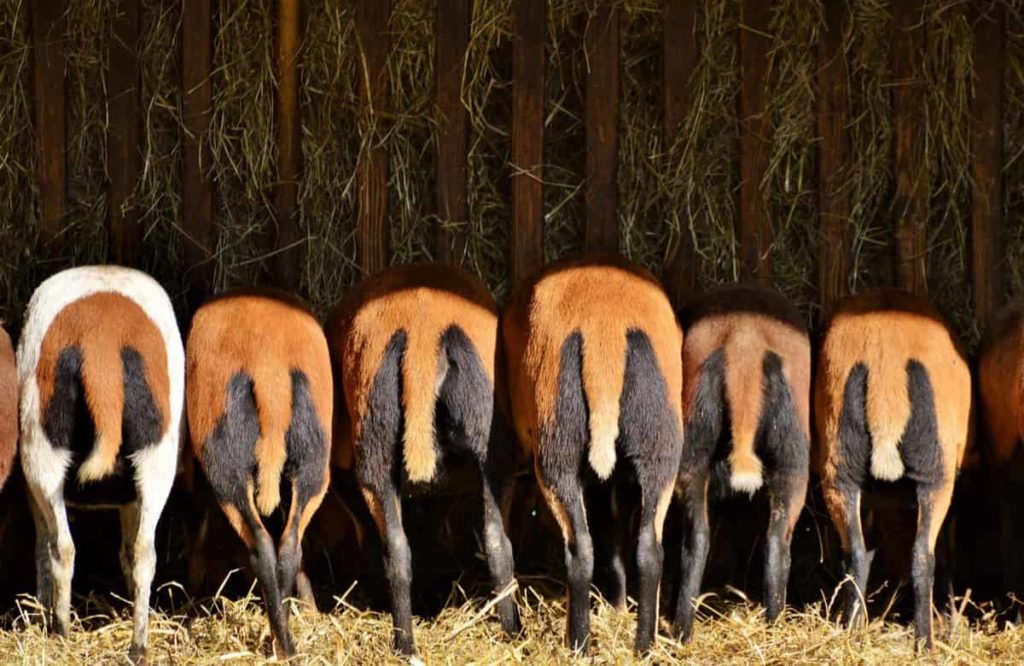
What are the essential nutrients for livestock?
As with any human diet, animals can only thrive if they have a properly nutritious diet put together for them. The difference is that they need their diet to be monitored by their breeders, and if the breeders are not equipped with the right information, they will not be able to provide the nutrients they need to perform well.
Energy – It is an important element in animals’ diets because it provides them with a source of energy for the work they need. It is also the source of their growth, reproduction, and lactation (dairy) during developmental stages. An animal’s energy intake is determined by the types of nutrients contained in the feed itself. As you would with your diet, you need to monitor the composition of the feed to ensure that the makeup of the feed is what the animal needs.
Protein – It is important in muscles, internal organs, hair, and skin structure. The feed you feed your animals will provide protein. Protein will provide cattle with the essential amino acids they need.
Fiber – The correct fiber content is extremely important as it allows for proper digestion and passage of the nutrients that the animal is eating.
Minerals – Minerals are the key to animal health. They directly affect the animal’s immune system.
Vitamins – You can see vitamins with the same importance as minerals as they are essential for the proper growth of animals.
What are the factors affecting feed intake in livestock?
Feeding the animals is important, but a few things need to be considered, and they determine the amount of food the animals need. These should be known to avoid wastage or lack of available feed. The following should be considered before feeding animals:
Seasonal/Weather Condition: The climate or weather condition determines the amount of animal feed. In hot weather, they take less food and drink more water, and vice versa in cold weather.
Health condition: A sick animal always has less or less appetite than a healthy animal.
Nature of feed: Animals are more interested in pelleted feed than fine or powdered feed. They take more of the pelleted food. Attention should be paid to the palatability of the feed because the more palatable the feed, the higher the feed intake.
Water availability: Water must be available before and after feeding the animals. Animals will take in enough food when they have enough water to drink during and after feeding.
Animal physiological Condition: The physiological condition of an animal will determine the amount of feed it will consume. For example, animals that raise young eat more food than those that don’t. Similarly, dairy cows that are milked regularly consume more feed and water than dry cows.
In case you missed it: How this Farmer Made 5 Lakh Profit from Sheep Farming – A Success Story
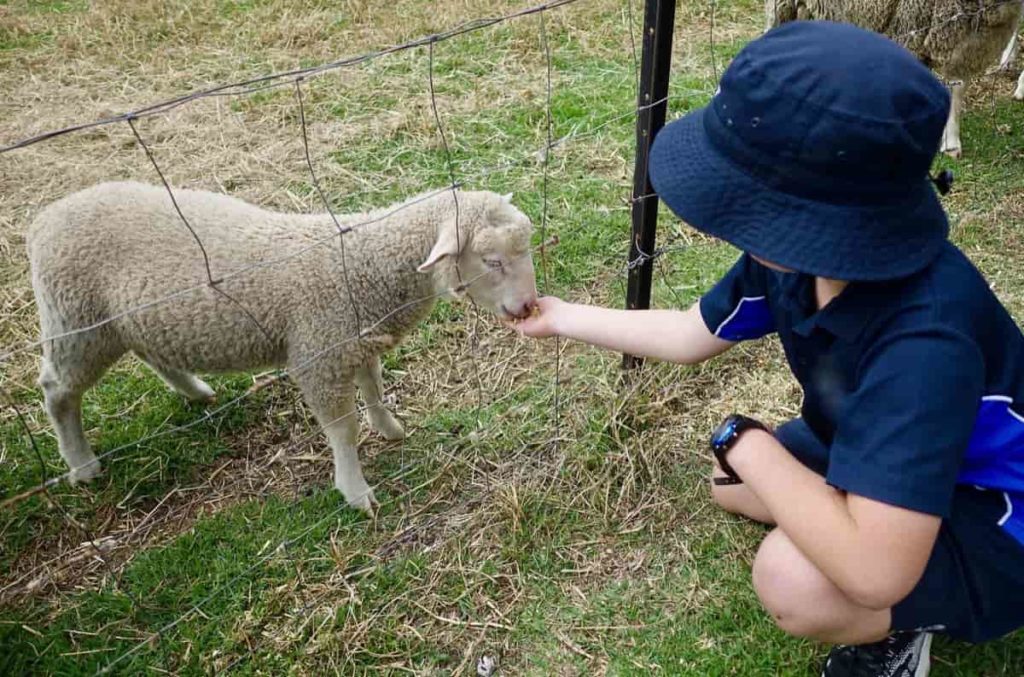
Conclusion
Good animal feed plays an important role in the health and welfare of animals and the production of safe and quality products of animal origin. The success of your livestock farm can depend on how you feed, handle and care for your animals. Keep in mind that livestock animals are very sensitive to what they eat and how they eat it. So, ensure to provide your livestock with all the essential nutrients, in the right amount and at the right time.
Animals require adequate nutrition for maintenance and growth and energy for work and vital functions. Maintenance nutrition helps the animal to maintain its current weight, while energy nutrition helps to perform important body functions. Adequate nutrition is also required for reproduction, maintaining body temperature, developing proper bone structure, and producing milk.
- Goat Farming Training Programs in India: A Beginner’s Guide
- Types of Pesticides Used in Agriculture: A Beginner’s Guide
- Economical Aquaculture: A Guide to Low-Budget Fish Farming
- 15 Common Planting Errors That Can Doom Your Fruit Trees
- How to Make Houseplants Bushy: Effective Tips and Ideas
- Innovative Strategies for Boosting Coconut Pollination and Yield
- Pollination Strategies for Maximum Pumpkin Yield
- The Complete Guide to Chicken Fattening: Strategies for Maximum Growth
- Natural Solutions for Tulip Problems: 100% Effective Remedies for Leaf and Bulb-Related Issues
- Revolutionizing Citrus Preservation: Towards a Healthier, Greener Future
- Natural Solutions for Peony Leaf and Flower Problems: 100% Effective Remedies
- Maximizing Profits with Avocado Contract Farming in India: A Comprehensive Guide
- Natural Solutions for Hydrangea Problems: 100% Effective Remedies for Leaf and Flowers
- The Ultimate Guide to Choosing the Perfect Foliage Friend: Bringing Life Indoors
- From Sunlight to Sustainability: 15 Ways to Use Solar Technology in Agriculture
- The Ultimate Guide to Dong Tao Chicken: Exploring from History to Raising
- The Eco-Friendly Makeover: How to Convert Your Unused Swimming Pool into a Fish Pond
- Mastering the Art of Delaware Chicken Farming: Essentials for Healthy Backyard Flocks
- 20 Best Homemade Fertilizers for Money Plant: DIY Recipes and Application Methods
- How to Craft a Comprehensive Free-Range Chicken Farming Business Plan
- Brighten Your Flock: Raising Easter Egger Chickens for Beauty and Bounty
- How to Optimize Your Poultry Egg Farm Business Plan with These Strategies
- Subsidy for Spirulina Cultivation: How Indian Government Schemes Encouraging Spirulina Farmers
- Ultimate Guide to Raising Dominique Chickens: Breeding, Feeding, Egg-Production, and Care
- Mastering the Art of Raising Jersey Giant Chickens: Care, Feeding, and More
- Ultimate Guide to Raising Legbar Chickens: Breeding, Farming Practices, Diet, Egg-Production
- How to Raise Welsummer Chickens: A Comprehensive Guide for Beginners
- How to Protect Indoor Plants in Winter: A Comprehensive Guide
- Ultimate Guide to Grow Bag Gardening: Tips, Tricks, and Planting Ideas for Urban Gardeners
- Guide to Lotus Cultivation: How to Propagate, Plant, Grow, Care, Cost, and Profit
- Agriculture Drone Subsidy Scheme: Government Kisan Subsidy, License, and How to Apply Online
- Ultimate Guide to Raising Araucana Chickens: Breed Profile, Farming Economics, Diet, and Care
- Bringing Hydroponics to Classroom: Importance, Benefits of Learning for School Students
- Ultimate Guide to Raising Polish Chickens: Breed Profile, Farming Economics, Diet, and Care
- Ultimate Guide to Raising Australorp Chickens: Profile, Farming Economics, Egg Production, Diet, and Care
- Silkie Chicken Farming: Raising Practices, Varieties, Egg Production, Diet, and Care